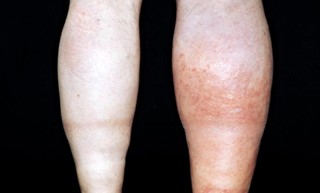Advice for patients following venous thromboembolism (VTE)
Read our guide below about the symptoms of a blood clot and what to do if you have one.
You can also download a PDF version of this patient information by following the link on the right.
What is venous thromboembolism (VTE)?
Venous Thromboembolism (VTE) is a condition in which a blood clot forms, most often in the deep veins of the leg, groin or arm, known as Deep Vein Thrombosis, (DVT).
These clots may break free and travel in the blood, lodging in the lungs, known as Pulmonary Embolism, (PE). Together, DVT and PE are known as venous thromboembolism (VTE).
Symptoms
Symptoms of DVT (deep vein thrombosis) in the leg are:
- Pain and tenderness in the leg (rarely both legs), usually in the calf or thigh.
- swelling in 1 leg (rarely both legs)
- warm skin around the painful area
- red or darkened skin around the painful area – this may be harder to see on brown or black skin
Symptoms of PE (Pulmonary Embolism) are:
- Unexplained shortness of breath
- Chest Pain that is worse when you breathe
- Coughing up blood
Other blood clots:
Sometimes a blood clot can happen in a vein in another part of your body, although this is very rare.
How is it treated?
- Blood-thinning medicines, called anticoagulants.
- You may have been given an injection of a blood-thinning medicine called heparin (Dalteparin) while awaiting test results.
- anticoagulant medicine stops blood clots getting bigger and prevents new clots forming.
- You will need to take these for at least 3 months. It is particularly important that you take these medicines correctly.
- HEPARIN e.g., Dalteparin before a confirmation scan.
- You may have an injection of a blood-thinning medicine called Heparin while you are waiting for a scan to see if you have a DVT (deep vein thrombosis), or a PE (Pulmonary Embolus).
- Direct oral anticoagulant tablets (DOACs) for example, Apixaban and Rixaroxaban.
- DOACs are tablets which are taken by mouth. You will usually be provided with a 3-month supply of the DOAC from the SDEC (Same Day Emergency Care).
- Warfarin
- Warfarin are tablets which are taken by mouth once a day. You will need to have regular blood tests while taking warfarin to make sure your dose is right.
- Warfarin can take some time to take effect so you will need to have injections of Dalteparin (a rapid working anticoagulant) until the warfarin begins to take effect. You will usually be provided with at least 7 days of Dalteparin and 3 different strengths of warfarin from SDEC (Same Day Emergency Care).
- You will be referred to the anticoagulation service who will contact you to arrange for you to have a blood test.
- If you have any questions or concerns, or you have not been contacted by the anticoagulation service, please contact them on 01494 323 600 (Option 1).
- Heparin injections.
- In some cases, you may be prescribed Dalteparin injections only. You will usually be provided with at least one month’s supply of these.
- It is important that you do not run out of injections.
- Contact your consultant to continue to provide these through the hospital pharmacy.
- Surgery (Thrombectomy).
- This is to remove blood clots. Occasionally patients are referred for mechanical removal of blood clots.
If you get a DVT when you’re pregnant, you’ll have injections for the rest of the pregnancy and until your baby is 6 weeks old.
Recovering from DVT
To help your recovery from Deep Vein Thrombosis, DVT, you should:
- walk regularly
- keep your affected leg raised when sitting
- discuss compression stockings with your GP if you still have swelling in your affected leg after 4 weeks
- delay any flights or long journeys until at least 2 weeks after you start taking blood thinning medicine.
Recovering from PE
To help your recovery from Pulmonary Embolism, PE, you should:
- gradually increase your activity levels back to normal
- give up smoking – get local support to help you stop or read general advice from the NHS.
You should make a full recovery from a pulmonary embolism if it’s spotted and treated early. Most patients begin to feel less breathless around 2 weeks after treatment and recover by 12 weeks.
What happens next?
The anticoagulation service will contact you within 7 days to check how you’re managing the medication we gave you.
Call 01494 323 600 (option 1) if you:
- have any questions or concerns
- anticoagulation service hasn’t contacted you.
More information
Find out more about how our anticoagulation service helps to treat and support your condition.
Learn more about the symptoms and treatment of DVT.
Find out more about the about the symptoms and treatment of PE.
Get useful resources and information about DVT, PE and VTE
What to do if you think you have symptoms of DVT
Call 999 or go to A&E
Symptoms include pain and swelling, breathlessness or chest pain.
For general medical advice visit the NHS website, call NHS 111 or talk to your GP.

